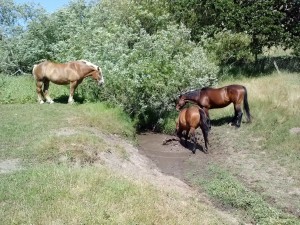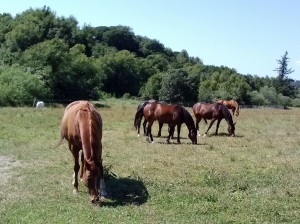 In my previous post I alluded to learning lessons from my friends at Equistar Farm, lessons I’m applying in surprising ways. Here is Lesson Number Two:
In my previous post I alluded to learning lessons from my friends at Equistar Farm, lessons I’m applying in surprising ways. Here is Lesson Number Two:
Watch Your Feet (or Head)
Another thing I’ve been doing, off and on for the last year and a half, is working as a Job Coach for the Department of Rehabilitation. When clients with disabilities get new jobs and need additional training and on-the-job-support, the DoR provides a Job Coach to go to work with them.
So far I’ve worked in grocery stores and hardware stores, training and supporting Courtesy Clerks (aka Baggers), Carry Out/Attendants and Stockers. I’ve learned a lot in the process! (Please be nice to your Baggers – I had no idea how hard they work, and what they have to put up with.)
Right now I’m coaching a client who is helping to build out a new grocery store. There is a crew of about 25 stockers, cashiers and inventory management people on site, installing fixtures, putting up shelving and stocking shelves – plus the construction people who are finishing with painting, electrical work and bolting down shelving. There are scissor lifts and pallet jacks moving around, and people carrying boxes, ladders and big pieces of metal.
I get to wear a hard hat (along with everyone else), and boy, am I glad – there are a lot of moving parts and bodies. We all have to keep our awareness up, not only for who/what is coming toward us but what’s on the ground and who we’re headed for. One wrong move and someone could get skewered, squished or run over.
As I was moving through this bee hive of activity, I was reminded of moving through the herd in the pasture and how I have learned to keep my awareness up about which horses are where, how they’re interacting with each other, where they’re heading, and whether they know where I am. One of the first lessons I learned – the hard way – was Watch Your Feet… after I didn’t pay attention and got stepped on by a 1200 pound bay gelding named Jake. (I’m fine…now.) I quickly learned the importance of watching my feet – and their hooves (and their rear-ends and their ears and their tails and their locations and what directions they’re moving).
There’s a difference between being Aware and being Wary
Even more importantly, I learned there’s a difference between being Aware and being Wary. It would have been easy to say, “I’ll never put myself in that situation again!” Instead, I chose, and choose, to put myself in that situation again and again. But I’m smarter about it. I can protect myself by being aware and present without having to be wary and keep others at arm’s length.
And the student becomes the teacher
All of this flashed through my head in an instant as people and equipment moved around me and someone walked casually by with a steel beam over his shoulder. I shared it with my client.
“You know, I’ve been working with a herd of horses.” He looked at me sideways. “When I’m in the middle of a bunch of animals who don’t want to hurt me but are a lot bigger than me, I’ve learned to protect myself by paying attention to where they are and what they’re doing. This is a lot like that.” He thought about it for a second, then nodded, grinning. He got it, and thought that was pretty cool.
So did I.
So, learning to be safe with the herd has helped me to be safe with others. And helped teach them to be safe. And it’s made me a better Job Coach.
It occurs to me as I write this that both of these lessons – working with shoppers and with construction crews – are about Safety, about helping others to feel safe, and about being safe. Hmmm.
Never a dull moment, eh?
Watch your feet.
Please leave a comment and
let me know what you think about this post!
And if you like it, please Like it on Facebook, +1 it or Tweet it!



 Twitter
Twitter LinkedIn
LinkedIn Facebook
Facebook